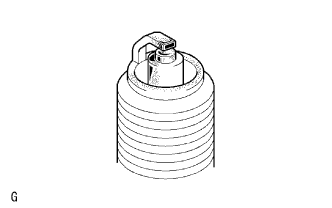Ignition System -- On-Vehicle Inspection |
- NOTICE:
- In this section, the terms "Cold" and "Hot" refer to the temperature of the sensor. "Cold" means approximately -10 to 50°C (14 to 122°F). "Hot" means approximately 50 to 100°C (122 to 212°F).
| 1. CHECK IGNITION COIL ASSEMBLY AND PERFORM SPARK TEST |
Check for DTCs.
- NOTICE:
- If any DTC is present, perform troubleshooting in accordance with the procedure for that DTC.
Check that sparks occur.
Remove the ignition coils.
Using a 16 mm plug wrench, remove the spark plugs.
Install the spark plugs to each ignition coil, and connect the ignition coil connectors.
Disconnect the 6 injector connectors.
Ground the spark plug.
Check if sparks occur at each spark plug while the engine is being cranked.
- NOTICE:
- Be sure to ground the spark plugs when checking them.
- Replace the ignition coil if it receives an impact.
- Do not crank the engine for more than 2 seconds.
- HINT:
- If sparks occur, skip the spark test flowchart.
- If sparks do not occur, proceed to the spark test flowchart.
Spark test flowchart.
Check that the wire harness side connector of the ignition coil with igniter is securely connected.
- Result:
Result Proceed to NG Connect securely OK Go to next step
Perform spark test on each ignition coil with igniter.
1. Replace the ignition coil with igniter with a normal one.
2. Perform spark test again.- Result:
Result Proceed to OK Replace ignition coil with igniter NG Go to next step
Check power supply to the ignition coil.
1. Turn the ignition switch ON.
2. Check that there is battery positive (+) voltage at the ignition coil positive (+) terminal.- Result:
Result Proceed to NG Check wiring between ignition switch and ignition coil assembly OK Go to next step
Check the resistance of the VVT sensor output voltage (Toyota Fortuner RM000000WBZ00TX.html).
- Result:
Result Proceed to NG Check that there is resistance between ECM and VVT sensor. If there is no resistance, replace VVT sensor. If there is resistance, repair wiring between VVT sensor and ECM OK Go to next step
Check the resistance of the crankshaft position sensor.
- Standard resistance:
Standard Condition Specified Condition Cold 1,630 to 2,740 Ω Hot 2,065 to 3,225 Ω
- Result:
Result Proceed to NG Replace crankshaft position sensor OK Go to next step
Check IGT signal from the ECM (Toyota Fortuner RM000000PDH00TX.html).
- Result:
Result Proceed to NG Check ECM
(Toyota Fortuner RM000000WBZ00TX.html)OK Repair wiring between ignition coil and ECM
Using a 16 mm plug wrench, install the spark plugs.
- Torque:
- 20 N*m{204 kgf*cm, 13 ft.*lbf}
Install the ignition coils.
- Torque:
- 10 N*m{102 kgf*cm, 7 ft.*lbf}
| 2. CHECK VVT SENSOR OUTPUT VOLTAGE |
Check the VVT sensor output voltage (Toyota Fortuner RM000000PDH00TX.html).
| 3. CHECK SPARK PLUG |
- NOTICE:
- Never use a wire brush for cleaning.
- Never attempt to adjust the electrode gap on a used spark plug.
Remove the engine cover.
Remove the air cleaner.
Remove the ignition coil.
Remove the spark plug.
Check the electrode.
Using a megohmmeter, measure the insulation resistance.
- Correct insulation resistance:
- 10 MΩ or more
- HINT:
- If a megohmmeter is not available, perform the following simple inspection instead.

Alternative inspection method:
Quickly accelerate the engine to 4,000 rpm 5 times.
Remove the spark plug.
Visually check the spark plug.
If the electrode is dry, the spark plug is functioning properly. If the electrode is damp, proceed to the next step.
 |
Check the spark plug for any damage on its threads and insulator.
If there is damage, replace the spark plug. If not, reinstall the spark plug.- Recommended spark plug:
Manufacturer Spark Plug Type DENSO K20HR-U11 NGK LFR6C11
Check the spark plug electrode gap.
- Maximum electrode gap for used spark plug:
- 1.3 mm (0.051 in.)
- Electrode gap for new spark plug:
- 1.0 to 1.1 mm (0.039 to 0.043 in.)
- NOTICE:
- When adjusting the gap of a new spark plug, bend only the base of the ground electrode. Do not touch the tip. Never attempt to adjust the gap of a used plug.
 |
Clean the spark plugs.
If the electrode has traces of wet carbon, clean the electrode with a spark plug cleaner and then dry it.- Standard air pressure:
- 588 kPa (6 kgf/cm2, 85 psi)
- Standard duration:
- 20 seconds or less
- HINT:
- Only use the spark plug cleaner when the electrode is free of oil. If the electrode has traces of oil, use gasoline to clean off the oil before using the spark plug cleaner.
 |